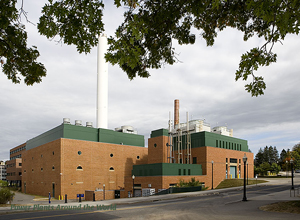UConn’s state-of-the-art Co-Generation Facility opened in February 2006, replacing several oil-fired utility boilers and enabling the University to meet its own energy needs at the main campus.

The Co-Generation Plant, which houses the cogeneration technology, is located centrally on the UConn Storrs campus.
Co-Generation is defined as the sequential production of both electrical or mechanical energy and useful thermal energy from a single energy source. This allows over 80% of the fuel energy to be harnessed, versus 33% from a conventional electric power plant.
The Co-Generation facility provides a two-fold reduction in emissions:
- Natural gas, a cleaner burning fuel, is used by the facility to generate electricity and steam for heating and evaporative cooling.
- Also, the inclusion of steam production in the process removes the need to construct separate steam-production facilities that would burn their own fuel and have their own emissions.
Most power plants on the electric grid are considerably less efficient than cogeneration facilities because they do not capture and utilize the steam for heating and cooling. Also, “distributed generation,” like UConn’s 25 MW Co-Generation facility, prevents the efficiency loss and congestion that occurs during transmission and distribution of electricity from the point of generation to distant electricity customers.
Due to these features, the UConn Co-Generation facility reduces carbon dioxide (greenhouse gas) emissions by an estimated 30,000 tons each year versus emissions from fossil-fueled power plants serving the regional electric grid.